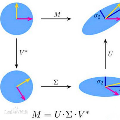Time-series data, such as unsteady pressure-sensitive paint (PSP) measurement data, may contain a significant amount of random noise. Thus, in this study, we investigated a noise-reduction method that combines multivariate singular spectrum analysis (MSSA) with low-dimensional data representation. MSSA is a state-space reconstruction technique that utilizes time-delay embedding, and the low-dimensional representation is achieved by projecting data onto the singular value decomposition (SVD) basis. The noise-reduction performance of the proposed method for unsteady PSP data, i.e., the projected MSSA, is compared with that of the truncated SVD method, one of the most employed noise-reduction methods. The result shows that the projected MSSA exhibits better performance in reducing random noise than the truncated SVD method. Additionally, in contrast to that of the truncated SVD method, the performance of the projected MSSA is less sensitive to the truncation rank. Furthermore, the projected MSSA achieves denoising effectively by extracting smooth trajectories in a state space from noisy input data. Expectedly, the projected MSSA will be effective for reducing random noise in not only PSP measurement data, but also various high-dimensional time-series data.
翻译:时间序列数据,如不固定压力敏感涂料测量数据,可能含有大量随机噪音。因此,在本研究中,我们调查了一种减少噪音的方法,这种方法将多变单谱分析(MSSA)与低维度数据代表制相结合。MSSA是一种州空间重建技术,使用时间间隔嵌入,而低维代表制则通过将数据投射到单值分解(SVD)的基础上来实现。拟议中的不固定PSP数据(即预测的MSSA)的减少噪音性能,与最常用的减少噪音方法(SVD)相比,我们研究了一种减少噪音的方法。结果显示,预测的MSSA在减少随机噪音方面表现优于悬浮的SVD方法。此外,与悬浮的SVD方法相比,预测的MSSA的性能对电解动等级不甚敏感。此外,预测的MASSA通过在预测的高度空间测量中提取平滑轨数据,而不是在预测的高度数据中通过预测的压流流流流数据序列进行有效的分解。


